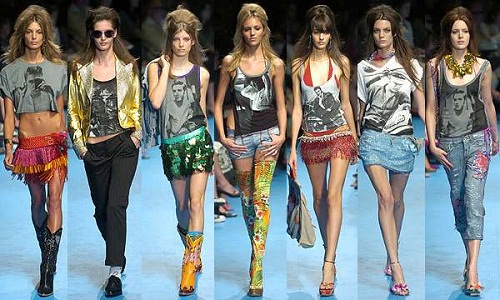"While global fashion industry is a major business generator, it still hasn’t been able to gain strong IP rights and protection. Even the world’s biggest economy, the US hasn’t shown any willingness to address this issue. For some critics, fashion designs are not art, and therefore, do not require similar protection, or that current laws sufficiently protect apparel and luxury brands. Added to that, the rapid turnover of new fashion designs makes IP protection useless because registrations do not typically issue until after copied designs reach the market. The ease of pirating fashion designs has outperformed legal developments especially in the US, which requires fashion companies and designers to become more strategic in their approach to IP protection."
 While global fashion industry is a major business generator, it still hasn’t been able to gain strong IP rights and protection. Even the world’s biggest economy, the US hasn’t shown any willingness to address this issue. For some critics, fashion designs are not art, and therefore, do not require similar protection, or that current laws sufficiently protect apparel and luxury brands. Added to that, the rapid turnover of new fashion designs makes IP protection useless because registrations do not typically issue until after copied designs reach the market. The ease of pirating fashion designs has outperformed legal developments especially in the US, which requires fashion companies and designers to become more strategic in their approach to IP protection.
While global fashion industry is a major business generator, it still hasn’t been able to gain strong IP rights and protection. Even the world’s biggest economy, the US hasn’t shown any willingness to address this issue. For some critics, fashion designs are not art, and therefore, do not require similar protection, or that current laws sufficiently protect apparel and luxury brands. Added to that, the rapid turnover of new fashion designs makes IP protection useless because registrations do not typically issue until after copied designs reach the market. The ease of pirating fashion designs has outperformed legal developments especially in the US, which requires fashion companies and designers to become more strategic in their approach to IP protection.
Added to this, the ambiguities within copyright laws limit the protection of these designs, with different results in different countries. Fast fashion retailers have attempted to legitimise and defend their production and sale of copied designs. Forever 21 has been charged over 50 times by different designers and has never actually lost a case, instead resolving lawsuits in settlements. In 2017, the retailer found itself involved in three of the most significant fashion lawsuits of the year with adidas and Gucci, and it still has not been deterred from producing and selling its copies of fashion brands’ products. In fact, in March 2017 Forever 21 went on the offence, making the bold decision to file suit against adidas, calling the German sportswear brand a ‘bully’. Industry insiders and IP lawyers alike are keeping a cautious eye on these cases to see which way the IP pendulum may swing.
Copyright laws in different countries
James Donoian and Margarita Wallach, McCarter & English, LLP in their analysis stated that France is the only country providing full copyright protection to fashion designs. French copyright laws protect ‘any original work expressed in any form’. The French system provides copyright protection regardless of the medium of the work. In addition: ‘originators of all creations of form, even the most modest, receive a generous bundle of economic and moral rights for a term of life plus 50 years from creation.’ While copyright laws in the United States offer minimal protection. In the US, functional objects such as articles of clothing are not protected by copyright. However, under the concept of separability, copyright may protect authorship in pictorial, graphic or sculptural designs that can be identified separately from or exist independently of the utilitarian aspects of the article (ie, when the design can be separated from the garment and stand on its own as a copyrightable work).
protection to fashion designs. French copyright laws protect ‘any original work expressed in any form’. The French system provides copyright protection regardless of the medium of the work. In addition: ‘originators of all creations of form, even the most modest, receive a generous bundle of economic and moral rights for a term of life plus 50 years from creation.’ While copyright laws in the United States offer minimal protection. In the US, functional objects such as articles of clothing are not protected by copyright. However, under the concept of separability, copyright may protect authorship in pictorial, graphic or sculptural designs that can be identified separately from or exist independently of the utilitarian aspects of the article (ie, when the design can be separated from the garment and stand on its own as a copyrightable work).
Counterfeits
Fashion companies and designers should register their brand names as trademarks to deter counterfeiting. Ideally, one should prioritise those countries where the brand is or imminently will be sold or manufactured. While certain jurisdictions recognise common law rights, registration provides the most protection; having an already registered trademark means there is no battle over who has the rights. Filing a trademark early may also prevent trademark squatting. Not only has e-commerce attributed to growth in sales of copycat designs; fast fashion retailers are also constantly opening new physical stores. Research has shown that some e-commerce fast fashion retailers present an astounding 700 new styles per week.
Design protection
To address copying of designs more fully, some countries are leading the way by adopting a new type of protection, sometimes simply referred to as ‘design rights’ or the ‘design law’. In 2001, the European Union recognised an expansive definition of ‘design’: The appearance of a whole or part of a product resulting from the features of, in particular, the lines, contours, shape, texture and/or materials of the product itself and/or its ornamentation. This concept has since been adopted by Japan, Brazil, India and Israel.
Under EU law, design protection exists as a registered or unregistered right. A registered right protects original designs for a renewable period of five years, with a maximum duration of 25 years from the original filing date. An unregistered right protects designs from blatant copies for a maximum of three years from the date the design was first made available to the public. As a result, the new design laws offer protection from infringers to both registered and unregistered designs. In addition, both design rights and copyright can protect fashion designs in countries that allow for cumulative protection.
In Japan by comparison, design law is determined by the Design Act. Under the Design Act only registered designs are legally protectable. Protection may still be provided under unfair competition law if the infringing garment is a dead copy of the original garment and if the infringing copy would raise confusion with the original garment in the minds of consumers.












